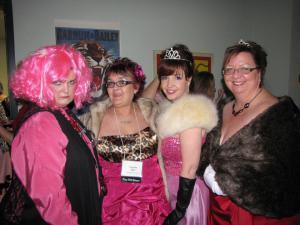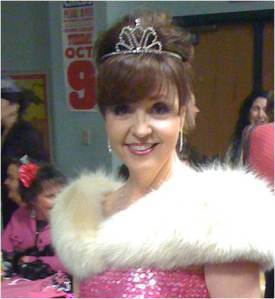Lynne Gentry's Blog, page 12
January 27, 2012
Mastering Body Language Earns a Best Actress Nomination
Today, in the Dallas Morning News movie critic Chris Vognar reviewed Glenn Close's Oscar nominated performance where she plays a man secretly living as a woman in order to earn a steady wage in the harsh 19th-century Irish economy.
Since we talk about body language on this blog, I found Vognar's critique fascinating:
"Playing a stoic butler in a 19th-century Dublin hotel, Close turns in a masterpiece of repressed stillness. Her performance is all in the economical movements and studying eyes of a servant between genders."
Remember only 7% of what we say communicates our meaning. 93% is communicated by our body language. This performance by Close reminds me of how important it is to move our characters around on pages of our novels.
I can't wait to see Albert Nobbs, a movie based on a short story by Irish novelist George Moore.
Check out this video of Glenn Close getting into makeup:
http://www.imdb.com/video/imdb/vi2930090265/








January 25, 2012
Oscar Nominations 2012
The Oscar Nominations came out today. Don't you know the designers are lining up, salivating over who gets to dress who in what.
This year, there are some classy ladies in the running. Can't wait to see what Meryl Streep, Glenn Close, and Viola Davis are wearing.
Achieving that perfect red carpet look is probably harder on the actors than learning their lines. But they'll do it. Why? Because something about glitz and glamour sure can make a girl feel pretty. I know I had fun getting all gussied up for this year's Pulpwood Queen's Pretty in Pink Prom in Jefferson, TX.

Kathy Patrick, Tiajuana, Lynne Gentry, Kellie Gilbert on the red carpet in Jefferson, TX
Who's dress are you dying to see at this year's Academy Awards?








January 16, 2012
Beauty Queens May Age, But They Never Really RETIRE their TIARAS
I can't tell you how excited I was to dust off my old tiaras for the Pulpwood Queen's Girlfriend Weekend. I have three tiaras … all of them won years ago. (Miss Kansas FFA being the biggest … impressive, right?)

Hairspray is a girl's best friend.
Pulpwood Queens is an annual gathering of the largest literary book club in America … one big party of famous authors mingling with avid readers.
The jam-packed event included TWO themed costume balls … Pretty in Pink Prom and The Great Big Ball of Hair Circus.
After I squeezed into my daughter's old prom dress and crammed my feet into some killer heels, I draped a borrowed fox fur around my shoulders and hung borrowed rhinestones on my ears. You'd think that the costume would have made me feel glamorous, but it wasn't until I set that crown on my head that feelings I hadn't felt in years hit me. Suddenly, I was a senior in high school – insecure and uncertain of the future, but excited to step out anyway because anything seemed possible.
When you dress your characters, consider giving meaning to a specific piece of the costume. Does the height their boots add more confidence? Does the sparkle of their earring remind them of the lackluster emotions they are feeling? Does a snug belt remind them of how easily things can go beyond their control?

Kellie Gilbert and I met Tina Sloan who played Lillian on Guiding Light








December 31, 2011
Resolved to Move Rocks
Welcoming a new year always causes a little meloncholy. Did any of my efforts this past year make a difference?
Then I came across the story of the Nazca Indians. On the desolate plains of southern Peru, strange lines cut through the pebble-covered expanse. From the ground, these strange barren patches don't make any sense. But from the sky, it appears that a giant finger drew a 300-yard long bird, a 50-yard long spider, and even a playful monkey …nearly 15,000 designs in all. Tons of small stones must have been moved to create the images.
How many years did it take to move all of those rocks? And after these dedicated quarry workers finished, they really couldn't see the whole picture because there's not even a tree to climb in the area. But the Nazcas moved the rocks anyway. We may never know why they did it. We just know that someone thought the job was worth doing.
In 2012, I resolve to keep movin' rocks. Plugging away at writing better stories. Working harder to spend quality time with my family. Smiling and laughing more. Doing my part to make the world a better place. Even if I can't see the whole picture today, I pray years from now someone will see how the pieces of my life fit into the puzzle.
Do you have some rocks that need moving?








December 16, 2011
Ebook Autographs
Technology is moving at the speed of light. I just found out that it is now possible for me to autograph my ebook, REINVENTING LEONA. It is so easy. All the reader has to do is go to www.kindlegraph.com, search for my book, and request an autograph. Who would have thought it possible?
Cyber book signing is fast, fun, and free (which is about what my autograph is worth).
Wonder how long before we won't have to make physical contact with anyone? Check it out and send me a request. I've got my cyber fingers all warmed up and ready to go.








December 5, 2011
4th Wiseman
Every Christmas, I ask myself, if I had been a student of the stars, would I have believed the new star in the sky announced the birth of a king?

George Donaldson - wise beyond years
Scott Crain asks the same question in Chasing Starlight. In this creative Christmas monologue, Crain examines the 4th Wiseman, an astrologer who made the fateful decision to stay home rather accompany his colleagues to investigate the brilliant light.
I love getting ready for our church's annual Christmas Eve service. First, I find a wiseman-looking fellow to perform the monologue. I rehearse him until he wants to shoot me. I insist he dig deeper into the motivation for the 4th Wiseman's fateful decision with every minute spent on the boards. Then I add the music that will underscore the piece. But I do not actually have a 4th Wiseman character until I break out the wiseman costume. Once I put the actor in the wiseman costume I can SEE characterization truly developed.
Something about the luxurious fabrics, sparkly sequins, and the turbaned hat transforms the actor into the 4th Wiseman.
God did the same thing for us.
He gave us a great script (His Word) and sent a cloud of witnesses to rehearse the benefits of his involvement in our lives. But it was not until the Incarnate donned the costume of humanity and became flesh that we could SEE our Creator's true character.
Lord, help me to continually don the character of Christ that the world may see you.








November 11, 2011
3 Things to Know about Dressing Historical Characters
Thrilled to have guest blogger and friend, historical writer Cathy Richmond.

Historical Author Cathy Richmond
Susannah had long ago given up on marriage. So when her parents died and her pastor sent her west to marry his brother, she wasn't thinking like a new bride. Her mindset was that of a grieving daughter, bound by strict rules of mourning to wear black. Jesse, her new husband, asked her to do a lot of changing, including her clothes. Their first Sunday together, he said, "I'd hoped celebrating our marriage would outweighmourning your folks."
Early drafts of Spring for Susannah had her changing into a calico dress. But when my publisher Thomas Nelson chose this dress for the cover, I wrote it into this first Sunday scene. The cover captures Susannah and Jesse's emotional distance – his frustration
and her reserve.
So what do you need to know about dressing historical
characters?
1. Clothing, including underwear, must be appropriate for the time period. Hairstyles, hats, and accessories changed, too. The 1870s, when Spring for Susannah was set, featured bustles, narrow sleeves, and lots of trimmings.
2. Socioeconomic pressures dictated clothing. White wedding dresses were available for wealthy women in the 1880s, but less well-to-do Laura Ingalls Wilder married in a brown dress that became her Sunday-best.
Regional styles prevailed. During the hoop-skirt era of the 1850s and 60s, Southern women wore wider hoops to keep heavy fabric away from their bodies. Women from small towns, with only one store, might all wear dresses made from the same fabric.
My go-to resources include:
American Victorian Costume by Priscilla Harris Dalrymple
Victorian Fashions and Costume from Harper's Bazar by Stella Blum
The History of Underclothes by C & P Cunnington
Museums – But most display fancy clothes from wealthy people, not everyday wear.
Reenactors and docents – Most love to share from their extensive research.

The Thomas Nelson Costume Closet -- doesn't it look fun
Check out Cathy's books at: www.CatherineRichmond.com








October 20, 2011
Body Language Alters Perceptions
What body language communicates matters so much that the Dallas Morning News carried an article about GOP hopeful Mitt Romney placing a hand on the shoulder of Rick Perry during their last debate. The words between these two opponents will be lost, but the perceived impressions will linger with the audience forever.
In the 1992 Presidential debate, the camera caught George W. Bush looking at his watch. A tiny gesture that made him appear bored negated the power of his spoken word.
Zoom the camera in on your characters. Giving them a smirk, a stride, a shrug of the shoulder can alter the reader's perception.
A picture worth a thousand words. Here's one of some trick or treaters we had. I'd made my face up like a witch, which you can't see because my back is to the camera.

Zoom in on little girl held by her grandmother. What does her face communicate?






 [image error]
[image error]
October 18, 2011
Writing Journey
Do you have a burning desire to write a novel? What if I told you the writing journey was a tough one? Would you still choose to write?
When I started down the road to publication, I had no idea how many times I would have to start over. I was certain my first novel attempt would give Francine Rivers a run for her money. Did I ever have lots to learn. Two women's fiction, one medical thriller, a time travel, and several short stories later I still have LOTS to learn.
I'd love to hear your pre-publication story. Hope this video inspires you to never give up on your dreams.

 [image error]
[image error]

 [image error]
[image error]
 [image error]
[image error]
October 8, 2011
Finding the Sweet Spot in Dialogue Writing
Today, Stage Write hosts guest author Staci Stallings:
Over the years I have heard complaints from friends, students, and family that
even if they could write the story they've always wanted to tell, they could
never get the dialogue to "sound right."
To write dialogue, four main modes of communication must dovetail for the
piece to sound believable and honest. The four are: Writing, Reading, Speaking, and Talking.
First, when writing dialogue, don't dwell on getting it perfect, listen to it
in your mind, and write it. Don't over-think this step.
The second form of communication is reading. Novice writers tend to skip this step.
Once you get your thoughts on paper, there will without question be something
that needs changing because reading is simply not the same as writing. Many
times I have gotten the words on paper, whether it be dialogue or simple prose,
and when I went back and reread it, it did not make the same sense it did coming out of my head. That's all right. Just change it.
One of the main problems with converting writing to reading is timing. In dialogue, timing is essential because the reader needs to "hear" the rhythm of the speech pattern. Use breaks to help with the rhythm and pacing of dialogue. For example, take two scenes with the same dialogue:
"Well." She glanced at the door. "I just don't know right now. Can you come back tomorrow?"
"No." The firmness of his hands on her shoulders pulled her gaze back to his eyes. "I need an answer now, and I'm not leaving until I get one."
Or:
"Well, I just don't know right now." Grabbing up the clothes basket, she pushed through the door into the sunshine. "Can you come back tomorrow?"
He followed her hurried steps through the garden to the clothesline. "No, I need an answer now." His gaze narrowed as he stepped in front of her. "And I'm not leaving until I get one."
Both dialogue sections give the reader more information than the simple words. In the first, her glance at the door could mean she is wishing she could run away or that she is hoping someone will come in that door and save her at the last minute. His hands on her shoulders give the impression that they know each other, and he wants to keep her from running.
The second example "feels" very different. In that section, she is running, but he doesn't seem to know her all that well. In fact, he seems to be more of an adversary in some business deal.
This leads us directly into the question of the actual quotes used in dialogue. The third form of communication is speaking. When rereading your dialogue after you have gotten it on paper, it is important to understand the difference between speaking and talking. Speaking is formal–like a minister giving a sermon or a lecturer giving a speech.
Very often these "speeches" are actually written out before they are delivered, thus causing the difference between speaking and the less formal form of communication-talking.
In writing, however, novice writers will often transfer speaking form into written form and call it done. Then they wonder why their dialogue sounds stilted. The reason is that speaking by its very nature is stilted. It is formal and meant to be so. Therefore, it is not speaking that we, as authors, are aiming at–it is a blend of speaking and talking.
Talking is the fourth form of communication. To learn how to convey realistic talking in dialogue become an active listener. Listen to how people talk. Listen to the inflection, to the tone, to the pitch. Listen to what they are saying beyond the words they use, but listen to the words as well.
So, the skilled writer must aim to have the right amount of talking, mixed with the right amount of speaking, in a written form that can be read while endeavoring to make every information break provide the precise pause necessary to improve the timing of the dialogue and to convey the desired information. Easy, right?
WHO IS STACI STALLINGS?
A stay-at-home mom with a husband, three kids and a writing addiction on the
side, Staci Stallings has numerous titles for readers to choose from. (Pick up the Price of Silence now for only $0.99! http://www.amazon.com/The-Price-of-Silence-ebook/dp/B004E9U7P6) Not content to stay in one genre and write it to death, Staci's stories run the gamut from young adult to adult, from motivational and inspirational to
full-out Christian and back again. Every title is a new adventure! That's what keeps Staci writing and you reading. Although she lives in Amarillo, Texas and her main career right
now is her family, Staci touches the lives of people across the globe every week with her various Internet endeavors including: Books In Print, Kindle, & FREE on Spirit Light Works: http://stacistallings.wordpress.com/
Spirit Light Books–The Blog: http://spiritlightbooks.wordpress.com/
And… Staci's website http://www.stacistallings.com Come on over for
a visit…You'll feel better for the experience!











